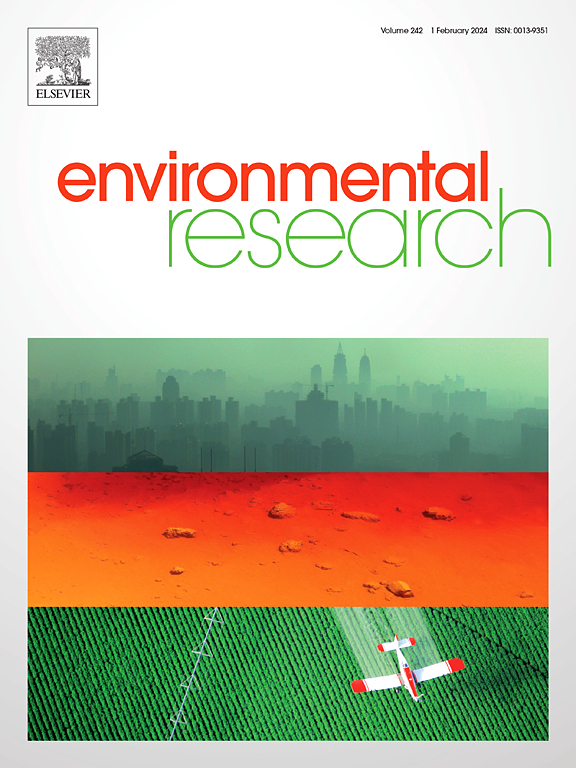In-utero exposure to real-life environmental chemicals disrupts gene expression within the hypothalamo-pituitary-gonadal axis of prepubertal and adult rams
IF 7.7
2区 环境科学与生态学
Q1 ENVIRONMENTAL SCIENCES
引用次数: 0
Abstract
Environmental chemicals (ECs) have been associated with a broad range of disorders and diseases. Daily exposure to various ECs in the environment, or real-life exposure, has raised significant public health concerns. Utilizing the biosolids-treated pasture (BTP) sheep model, this study demonstrates that in-utero exposure to a real-life EC mixture disrupts hypothalamo-pituitary-gonadal (HPG) axis gene expression and reproductive traits in prepubertal (8-week-old, 8w) and adult (11-month-old) male sheep. Ewes were maintained on either BTP or pastures fertilized with inorganic fertilizer [control (C)] from approximately one month prior to insemination until around parturition. Thereafter, all animals were kept under control conditions. Effects on reproductive parameters including testosterone concentrations and the expression of key genes in the HPG axis were evaluated in eight-week-old and adult male offspring from both C and biosolids-exposed (B) groups. Results showed that, at 8w, relative to C (n = 11), B males (n = 11) had lower body weight, and altered testicular expression of HSD3B1, LHR and HSD17B3, BMP4, ABP, P27kip and CELF1. Principal component analysis (PCA) identified two 8w B subgroups, based on hypothalamic expression of GnRH, ESR1, and AR, and pituitary expression of KISSR. The two subgroups also exhibited different serum testosterone concentrations. The largest biosolids effects were observed in the hypothalamus of adult rams with NKB, ESR1, KISS1, AR, DLK1 and GNRH1 mRNA expression differing between B (n = 10) and C (n = 11) rams. Testicular steroidogenic enzymes CYP11A1 and HSD3B1 mRNA expression also differed between exposure groups. PCA identified two adult B subgroups, with BS1 (n = 6) displaying hypothalamic effects and BS2 (n = 4) both hypothalamic and testicular effects. The subgroups also differed in circulating testosterone concentrations. These findings demonstrate that exposure to a real-life EC mixture may predispose some males to infertility, by disrupting key functional HPG markers before puberty with consequent downstream effects on steroid hormones and spermatogenesis.

胎儿期暴露于真实环境中的化学物质会干扰青春期前和成年公羊下丘脑-垂体-性腺轴的基因表达。
环境化学品(ECs)与多种失调和疾病有关。每天暴露于环境中的各种ECs(即实际生活中的暴露)已引起了公众对健康的极大关注。本研究利用经生物固体处理的牧场(BTP)绵羊模型,证明胎儿期暴露于现实生活中的EC混合物会干扰青春期前(8周大,8w)和成年(11个月大)雄性绵羊的下丘脑-垂体-性腺(HPG)轴基因表达和生殖特征。从受精前约一个月到分娩前后,母羊一直饲养在BTP或施用无机肥的牧场(对照组(C))上。此后,所有动物均在对照条件下饲养。评估了 C 组和生物固体暴露组(B 组)8 周大雄性后代和成年雄性后代的生殖参数,包括睾酮浓度和 HPG 轴关键基因的表达。结果显示,相对于C组(n = 11),B组雄性(n = 11)在8周时体重较轻,HSD3B1、LHR和HSD17B3、BMP4、ABP、P27kip和CELF1的睾丸表达发生了改变。根据下丘脑的 GnRH、ESR1 和 AR 表达以及垂体的 KISSR 表达,主成分分析(PCA)确定了两个 8w B 亚组。这两个亚群还表现出不同的血清睾酮浓度。在成年公羊的下丘脑中观察到了最大的生物固体影响,NKB、ESR1、KISS1、AR、DLK1 和 GNRH1 mRNA 的表达在 B 组(n = 10)和 C 组(n = 11)之间存在差异。不同暴露组的睾丸类固醇生成酶 CYP11A1 和 HSD3B1 mRNA 表达量也不同。PCA 确定了两个成年 B 亚组,其中 BS1(n = 6)对下丘脑有影响,BS2(n = 4)对下丘脑和睾丸都有影响。这些亚组在循环睾酮浓度方面也存在差异。这些研究结果表明,暴露于现实生活中的氨基甲酸乙酯混合物可能会扰乱青春期前的关键功能性HPG标志物,从而对类固醇激素和精子发生产生下游影响,导致一些男性不育。
本文章由计算机程序翻译,如有差异,请以英文原文为准。
求助全文
约1分钟内获得全文
求助全文
来源期刊

Environmental Research
环境科学-公共卫生、环境卫生与职业卫生
CiteScore
12.60
自引率
8.40%
发文量
2480
审稿时长
4.7 months
期刊介绍:
The Environmental Research journal presents a broad range of interdisciplinary research, focused on addressing worldwide environmental concerns and featuring innovative findings. Our publication strives to explore relevant anthropogenic issues across various environmental sectors, showcasing practical applications in real-life settings.
 求助内容:
求助内容: 应助结果提醒方式:
应助结果提醒方式:


